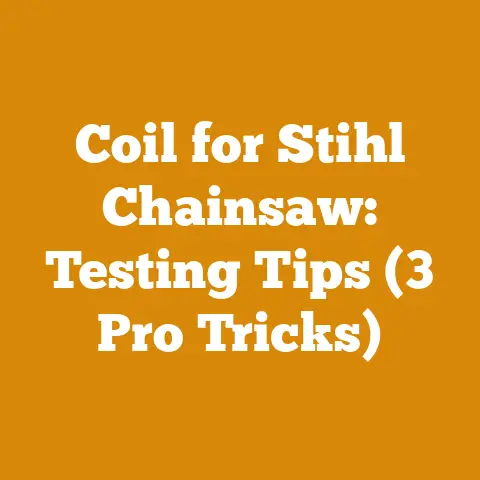How to Propagate Apple Tree (Grafting & Woodcutting Tips)
In the world of homesteading and horticulture, few things rival the satisfaction of nurturing your own fruit trees.
It not only saves you the cost of buying established trees but also allows you to customize your orchard with specific varieties perfectly suited to your climate and taste.
This guide will take you through the intricate yet rewarding process of propagating apple trees, offering technical details, practical tips, and safety guidelines to ensure your success.
Understanding Apple Tree Propagation: Grafting and Woodcutting
Apple trees, unlike some other fruit trees, don’t “come true” from seed.
This means that if you plant an apple seed, the resulting tree will likely produce fruit that is different from the parent apple.
To ensure you get the desired apple variety, you need to use vegetative propagation methods: grafting and woodcutting.
- Grafting: This involves joining a piece of a desired apple variety (the scion) onto the root system of another apple tree (the rootstock).
The scion provides the desired fruit characteristics, while the rootstock influences the tree’s size, vigor, disease resistance, and cold hardiness. - Woodcutting: This method involves rooting a piece of stem or root from the desired apple variety.
While less common for apple trees than grafting, it can be successful with certain techniques and varieties.
Grafting Apple Trees: A Step-by-Step Guide
Grafting is the most common and reliable method for propagating apple trees.
It allows you to combine the desirable traits of two different apple trees into one.
Rootstock Selection: The Foundation of Your Orchard
The rootstock is the base upon which your apple tree will grow, and its selection is crucial for the tree’s overall health and productivity.
Different rootstocks influence:
- Tree Size: Rootstocks are classified as dwarfing, semi-dwarfing, semi-standard, and standard.
Dwarfing rootstocks result in smaller trees (6-10 feet tall), making them ideal for small gardens or high-density orchards.
Standard rootstocks produce large trees (20-30 feet tall) suitable for larger properties.
Semi-dwarfing and semi-standard rootstocks fall in between. - Disease Resistance: Some rootstocks are more resistant to certain diseases, such as fire blight or apple scab.
- Cold Hardiness: Different rootstocks exhibit varying degrees of cold hardiness, making them suitable for different climates.
- Precocity: This refers to how quickly the tree begins to bear fruit.
Dwarfing rootstocks tend to be more precocious than standard rootstocks.
Popular Apple Rootstocks:
Technical Specifications for Rootstock:
- Diameter: Rootstock should be approximately 1/4 to 1/2 inch in diameter for grafting.
- Age: One to two-year-old rootstock is ideal.
- Storage: Store dormant rootstock in a cool, moist environment (32-40°F) wrapped in damp burlap or peat moss.
My Experience: I once grafted several apple trees using MM.111 rootstock in a particularly challenging location with poor soil.
The MM.111 proved to be incredibly resilient, and those trees are now thriving, producing abundant crops of apples.
The lesson here is that the right rootstock can make all the difference, especially in less-than-ideal conditions.
Scion Selection: Choosing Your Desired Variety
The scion is the piece of branch that will become the fruiting part of your apple tree.
It’s crucial to select scion wood from a healthy, disease-free tree of the desired variety.
Scion Wood Selection Criteria:
- Source: Choose scion wood from a known and reliable source.
Avoid taking scion wood from trees that show signs of disease or pest infestation. - Age: Select one-year-old growth (the previous season’s growth).
This wood is typically smooth, flexible, and has plump buds. - Diameter: Scion wood should be approximately the same diameter as the rootstock (1/4 to 1/2 inch).
- Dormancy: Scion wood must be dormant when collected.
This is typically done in late winter or early spring before the buds begin to swell.
Collecting and Storing Scion Wood:
- Timing: Collect scion wood in late winter or early spring before bud break.
- Selection: Choose healthy, vigorous branches with plump buds.
- Cutting: Cut scion wood into 12-18 inch lengths.
- Labeling: Label each bundle of scion wood with the variety name and the date of collection.
- Storage: Wrap scion wood in damp paper towels or burlap and store in a plastic bag in the refrigerator (32-40°F).
Technical Specifications for Scion Wood:
- Moisture Content: Scion wood should have a moisture content of around 40-50% for optimal grafting success.
- Bud Count: Each scion piece should have at least 3-4 healthy buds.
Personal Insight: I once made the mistake of collecting scion wood too late in the spring, after the buds had already started to swell.
The grafting success rate was significantly lower compared to when I collected dormant scion wood.
This experience taught me the importance of timing in grafting.
Grafting Techniques: Mastering the Art of Union
Several grafting techniques can be used for apple trees, but the most common and beginner-friendly methods are:
- Whip and Tongue Graft: This is a strong and reliable graft that provides a large surface area for cambial contact.
- Cleft Graft: This is a good option for grafting a smaller scion onto a larger rootstock.
- Bark Graft: This is typically done in the spring when the bark is slipping (easily separated from the wood).
Whip and Tongue Graft: Step-by-Step Guide
- Prepare the Rootstock: Make a long, sloping cut (about 1-2 inches long) on the rootstock.
Then, make a “tongue” cut by slicing downward into the cut surface, about halfway down the slope. - Prepare the Scion: Make a matching long, sloping cut on the scion.
Then, make a “tongue” cut by slicing upward into the cut surface, about halfway up the slope. - Join the Scion and Rootstock: Interlock the tongues of the scion and rootstock, ensuring that the cambium layers (the green layer just under the bark) are in contact on at least one side.
- Wrap the Graft Union: Wrap the graft union tightly with grafting tape or grafting rubber to hold the scion and rootstock together and prevent moisture loss.
- Seal the Graft Union: Apply grafting wax to seal the exposed cut surfaces and prevent disease or insect entry.
Technical Specifications for Whip and Tongue Graft:
- Cut Angle: The sloping cut should be at an angle of approximately 20-30 degrees.
- Cambial Alignment: Ensure that the cambium layers are in contact on at least one side for successful grafting.
- Grafting Tape Overlap: Overlap the grafting tape by at least 50% to ensure a tight seal.
Cleft Graft: Step-by-Step Guide
- Prepare the Rootstock: Cut the rootstock off cleanly at a right angle.
Use a grafting knife or a sharp knife to split the rootstock down the center to a depth of about 2-3 inches. - Prepare the Scions: Cut the base of each scion into a wedge shape, about 1-2 inches long.
- Insert the Scions: Insert one scion into each side of the cleft in the rootstock, ensuring that the cambium layers are in contact.
- Wrap and Seal the Graft Union: Wrap the graft union tightly with grafting tape and seal all exposed cut surfaces with grafting wax.
Technical Specifications for Cleft Graft:
- Cleft Depth: The cleft should be deep enough to accommodate the wedge-shaped scion pieces.
- Scion Wedge Angle: The angle of the wedge cut on the scion should match the angle of the cleft.
Bark Graft: Step-by-Step Guide
- Prepare the Rootstock: In the spring, when the bark is slipping, cut the rootstock off cleanly at a right angle.
Make vertical slits in the bark, about 2-3 inches long. - Prepare the Scions: Cut the base of each scion into a long, sloping cut on one side.
- Insert the Scions: Gently lift the bark flaps along the vertical slits and insert the scions, with the cut surface facing inward, between the bark and the wood.
- Wrap and Seal the Graft Union: Wrap the graft union tightly with grafting tape and seal all exposed cut surfaces with grafting wax.
Technical Specifications for Bark Graft:
- Bark Slippage: The bark must be easily separated from the wood for successful bark grafting.
- Scion Cut Length: The sloping cut on the scion should be long enough to ensure good contact with the cambium layer.
Tools Required for Grafting:
- Grafting Knife: A sharp, specialized knife for making clean cuts.
- Pruning Shears: For cutting rootstock and scion wood.
- Grafting Tape: To hold the scion and rootstock together.
- Grafting Wax: To seal the graft union and prevent moisture loss.
- Hand Sanitizer or Rubbing Alcohol: To sterilize tools and prevent the spread of diseases.
Tool Calibration Standards:
- Grafting Knife Sharpness: The grafting knife should be razor-sharp to make clean, precise cuts.
Sharpen the knife regularly using a sharpening stone or honing steel. - Pruning Shear Alignment: Ensure that the blades of the pruning shears are properly aligned to make clean cuts without crushing the wood.
Safety Equipment Requirements:
- Gloves: Wear gloves to protect your hands from cuts and scrapes.
- Eye Protection: Wear safety glasses or goggles to protect your eyes from flying debris.
My Personal Story: I remember my first attempt at cleft grafting.
I was so eager to get started that I rushed the process and didn’t pay close enough attention to cambial alignment.
Unsurprisingly, most of those grafts failed.
It was a humbling experience that taught me the importance of patience and precision in grafting.
Post-Grafting Care: Nurturing Your New Tree
After grafting, it’s crucial to provide proper care to ensure the graft union heals and the new tree thrives.
Post-Grafting Care Tips:
- Protection: Protect the newly grafted tree from extreme weather conditions, such as frost or excessive heat.
- Watering: Water the tree regularly, especially during dry periods.
- Weed Control: Keep the area around the tree free of weeds.
- Pest and Disease Management: Monitor the tree for signs of pests or diseases and take appropriate action.
- Grafting Tape Removal: After a few months, once the graft union has healed, carefully remove the grafting tape to prevent girdling.
Data Points and Statistics:
- Grafting Success Rate: The success rate of grafting can vary depending on the technique used, the skill of the grafter, and the environmental conditions.
However, with proper technique and care, a success rate of 70-90% is achievable. - Healing Time: The graft union typically takes 4-8 weeks to heal completely.
Woodcutting Apple Trees: A Less Common but Viable Option
While grafting is the preferred method for propagating apple trees, woodcutting can also be successful, especially with certain varieties and techniques.
Types of Apple Tree Cuttings:
- Hardwood Cuttings: These are taken from dormant, mature wood in late fall or early winter.
- Semi-Hardwood Cuttings: These are taken from partially matured wood in late summer.
- Root Cuttings: These are taken from the roots of the tree during the dormant season.
Hardwood Cuttings: Step-by-Step Guide
- Timing: Take hardwood cuttings in late fall or early winter after the leaves have fallen.
- Selection: Choose healthy, one-year-old wood, about 6-8 inches long and 1/4 to 1/2 inch in diameter.
- Cutting: Make a clean cut at a 45-degree angle at the base of the cutting and a straight cut at the top.
- Callusing: Dip the base of the cutting in rooting hormone.
- Planting: Plant the cuttings in a well-drained rooting medium, such as a mixture of perlite and peat moss, burying about two-thirds of the cutting.
- Overwintering: Overwinter the cuttings in a cold frame or unheated greenhouse.
- Transplanting: In the spring, after the cuttings have rooted, transplant them into individual pots or directly into the ground.
Technical Specifications for Hardwood Cuttings:
- Cutting Length: 6-8 inches.
- Cutting Diameter: 1/4 to 1/2 inch.
- Rooting Hormone Concentration: Follow the manufacturer’s instructions for the specific rooting hormone used.
- Rooting Medium Moisture: The rooting medium should be moist but not waterlogged.
Semi-Hardwood Cuttings: Step-by-Step Guide
- Timing: Take semi-hardwood cuttings in late summer.
- Selection: Choose partially matured wood from the current season’s growth, about 4-6 inches long.
- Cutting: Make a clean cut at a 45-degree angle at the base of the cutting and remove the lower leaves.
- Callusing: Dip the base of the cutting in rooting hormone.
- Planting: Plant the cuttings in a well-drained rooting medium, such as a mixture of perlite and peat moss.
- Humidity: Place the cuttings in a humidity dome or mist them regularly to maintain high humidity.
- Rooting: The cuttings should root in 4-8 weeks.
- Transplanting: After the cuttings have rooted, transplant them into individual pots or directly into the ground.
Technical Specifications for Semi-Hardwood Cuttings:
- Cutting Length: 4-6 inches.
- Leaf Removal: Remove the lower leaves to reduce moisture loss.
- Humidity Level: Maintain a humidity level of 80-90% for optimal rooting.
Root Cuttings: Step-by-Step Guide
- Timing: Take root cuttings during the dormant season (late fall or early spring).
- Selection: Choose healthy, pencil-thick roots.
- Cutting: Cut the roots into 2-4 inch lengths.
- Planting: Plant the root cuttings horizontally in a well-drained rooting medium, burying them about 1 inch deep.
- Watering: Keep the rooting medium moist but not waterlogged.
- Rooting: The cuttings should root in a few weeks.
- Transplanting: After the cuttings have rooted, transplant them into individual pots or directly into the ground.
Technical Specifications for Root Cuttings:
- Cutting Length: 2-4 inches.
- Root Diameter: Pencil-thick.
- Planting Depth: 1 inch.
Factors Affecting Rooting Success:
- Variety: Some apple varieties root more easily from cuttings than others.
- Rooting Hormone: The use of rooting hormone can significantly increase the success rate of rooting cuttings.
- Humidity: Maintaining high humidity is crucial for preventing cuttings from drying out.
- Temperature: A warm soil temperature (around 70-75°F) promotes root development.
- Light: Provide indirect light to prevent the cuttings from overheating.
My Experience: I’ve had limited success with rooting apple tree cuttings, but I’ve found that using a humidity dome and a heat mat significantly improves the rooting rate.
It’s also important to choose a variety that is known to root relatively easily from cuttings.
Safety Considerations for Apple Tree Propagation
Propagating apple trees involves the use of sharp tools and potentially hazardous materials.
It’s essential to follow safety precautions to prevent injuries and ensure a safe working environment.
Safety Guidelines:
- Wear appropriate safety gear: This includes gloves, eye protection, and sturdy shoes.
- Use sharp tools with caution: Always cut away from your body and keep your fingers clear of the blade.
- Sterilize tools regularly: This helps prevent the spread of diseases.
- Store tools properly: Keep sharp tools out of reach of children and pets.
- Dispose of waste materials properly: Dispose of grafting tape, grafting wax, and other waste materials in a designated container.
- Be aware of your surroundings: Watch out for tripping hazards and other potential dangers.
First Aid:
- Cuts and Scrapes: Clean the wound thoroughly with soap and water and apply a bandage.
- Eye Injuries: Flush the eye with water for 15 minutes and seek medical attention.
- Allergic Reactions: Seek medical attention if you experience an allergic reaction to grafting wax or other materials.
Data Points and Statistics:
- Tool-Related Injuries: According to the National Safety Council, hand tools are a leading cause of workplace injuries.
It’s essential to use tools properly and wear appropriate safety gear to prevent injuries. - Chemical Exposure: Some grafting waxes contain chemicals that can be harmful if inhaled or ingested.
Follow the manufacturer’s instructions for safe handling and storage.
Troubleshooting Common Propagation Problems
Even with the best techniques and care, you may encounter problems when propagating apple trees.
Here are some common issues and how to troubleshoot them:
- Graft Failure: This can be caused by poor cambial alignment, incompatible rootstock and scion, disease, or insect infestation.
- Troubleshooting: Ensure that the cambium layers are in contact on at least one side.
Use compatible rootstock and scion varieties.
Protect the graft union from disease and insects.
- Troubleshooting: Ensure that the cambium layers are in contact on at least one side.
- Cuttings Not Rooting: This can be caused by low humidity, improper rooting medium, or lack of rooting hormone.
- Troubleshooting: Maintain high humidity by using a humidity dome or misting the cuttings regularly.
Use a well-drained rooting medium.
Apply rooting hormone to the base of the cuttings.
- Troubleshooting: Maintain high humidity by using a humidity dome or misting the cuttings regularly.
- Disease and Pest Problems: Apple trees are susceptible to various diseases and pests, such as fire blight, apple scab, and aphids.
- Troubleshooting: Choose disease-resistant rootstock and scion varieties.
Monitor the trees regularly for signs of pests or diseases.
Use appropriate pest and disease control measures.
- Troubleshooting: Choose disease-resistant rootstock and scion varieties.
Case Study: Overcoming Graft Failure
I once had a series of grafts fail due to what I later discovered was a fungal infection in my grafting wax.
The wax appeared normal, but it was contaminated.
After switching to a different brand of grafting wax and sterilizing my tools more thoroughly, my grafting success rate improved dramatically.
This experience highlighted the importance of using high-quality materials and maintaining a sterile environment.
Conclusion: The Fruits of Your Labor
Propagating apple trees, whether through grafting or woodcutting, is a rewarding and cost-effective way to expand your orchard and enjoy a wider variety of apples.
While it requires patience, attention to detail, and adherence to safety guidelines, the satisfaction of nurturing your own apple trees from start to finish is unparalleled.
By following the technical details, practical tips, and troubleshooting advice in this guide, you’ll be well on your way to harvesting the fruits of your labor for years to come.
Remember, every successful orchard starts with a single, carefully grafted or rooted tree.
So, get out there, get your hands dirty, and start propagating!






